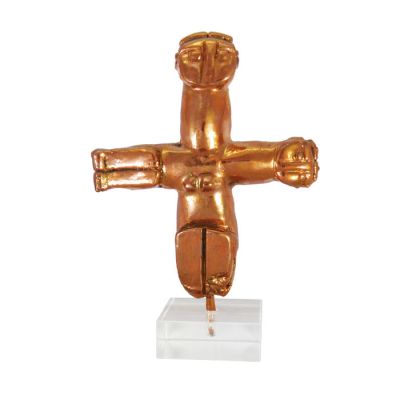The cross-shaped (cruciform) figurine, made of picrolite, from the district of Paphos in Cyprus, dated during the Chalcolithic period (3900-2500 B.C.), inspired us to create a copper copy of the figurine. It is a double figurine of two forms, forming a right angle. The figurine stands on an acrylic base (plexiglass), so it is easier for you to decorate your office with this marvellous piece of art.
Dimensions: 9cm x 13cm x 4cm
All prices include VAT.
In the Chalcolithic period (3900-2500 BC) a considerable number of highly stylized human figurines were produced in Cyprus. They were made of soft stone (picrolite) and had usually a cruciform appearance. Many similar sculptures from Cyprus can be seen at the museum of Cycladic Art in Athens. Cross-shaped figurines have been found at the district of Paphos, like the Idol of Pomos. The sculpture is on display in the Cyprus Archeological Museum in Lefkosia (Nicosia).
Cruciform figurines have most probably developed from the stump-like figurines of the preceding Neolithic period, but are thinner and more slender than their predecessors. They have a high neck, disproportionately large flattish head slightly tilted back, extended arms, and legs bent at the knees or in a squatting posture. Sex is rarely indicated by breasts rendered in relief. The size of the figurines ranges from 5 to 15 cm. They were probably used as fertility symbols.
The squatting posture denotes childbirth. Cruciform figurines are mostly found in child and female burials, and in all probability reflect religious beliefs about fertility and re-generation. Beliefs associated with perceptions of the afterlife are not excluded. The main form of this figurine is female, greater than the secondary, which has no suggestion of any sex. The figurines depict two forms in cruciform arrangement. These two forms may represent precursors of the dual deities of the prehistoric Mediterranean.
Some of them bear suspension-hole in the upper part of the head and were apparently worn as pendants. Those, that did not bear a suspension hole, were folded in clothing. Smaller versions were worn as amulets around the neck. Similar small figurines adorn the neck of cross-shaped clay figurines of Chalcolithic age, that were used as talismans for childbirth. The pendants were probably worn by women during pregnancy or in rituals related to fertility.
No posts found









